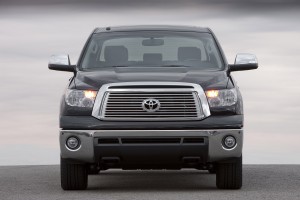
Coming at you. Toyota reported a 55% jump in Tundra sales, demand for trucks running high in January, despite $3 gas.
Though Winter storms and leftover holiday bills appeared to slow things down during the final weeks of the month, January car sales remained strong enough to leave industry officials upbeat about the prospects for the rest of 2011.
Sales were off by double-digits from December, when the auto industry staged an unexpectedly substantial turnaround – and the best volumes for all of 2010 – but January has traditionally been the year’s slowest month. And compared to year-earlier levels, the trendline appears to be pointing sharply upward.
Though several foreign makers have yet to issue their final numbers, it appears January will have seen the industry post a close to 20% gain over the first month of 2010. Collectively, Detroit’s makers posted some of the strongest gains overall, with each up by double-digits and two of the makers picking up market share from their import rivals.
But after three months of counter-trend losses, Toyota finally appears to have hit bottom, the maker reporting a 17.3% gain, for January, on a daily sales basis.
Significantly, industry insiders noted that the January numbers were solid despite a very slight decrease in spending on incentives.
“Consumers are driving much of the gains we’re seeing in the industry,” proclaimed Don Johnson, General Motors top U.S. sales executive.
December’s strong performance was driven, in large part, by a resumption of car purchases by daily rental and other fleet buyers. Generally, these are considered low-profit customers, where retail demand is a foundation for stronger profits. Notably, GM’s fleet sales fell 6%, year-over-year, but retail demand soared 36%. And its domestic competitors saw a similar shift.
So did many of the imports. So, while Hyundai’s sales rose 22% overall, the maker reported a 58% increase in retail demand for January.
The January sales numbers were encouraging to observers worried about the impact of rising fuel prices, which have topped $3 a gallon across the country – and which some experts now predict could climb as high as $5 a gallon.
But prices are “moving up very slowly, without any spikes, so people aren’t panicking like they did in 2008,” said George Peterson, chief analyst with AutoPacific, Inc. “They’re absorbing it. This isn’t the sort of situation that will get people to swarm back into small cars.”
If anything, car sales support other indicators of a rebounding economy, with a noticeable increase in demand for light trucks, especially the heavy-duty pickups that are favored by contractors. Toyota reported a 55.9% jump in demand for its full-size Tundra truck, for example.
“We are encouraged by last month’s results, which show continued strength in both the passenger and light truck segments,” said Toyota Division General Manager Bob Carter, who added that the troubled maker’s loyalty and conquest rates have returned to traditional levels.
The increases on the truck side come as particularly good news for Chrysler, which is still among the most truck-dependent of makers in the industry. Of its four brands, the flagship Chrysler marque reported a 7% sales drop, but the truck-heavy Dodge and Ram brands were each up more than 20%. And the Jeep division saw demand for its nearly-redesigned Grand Cherokee soar by 130%.
Overall, Chrysler reported its 10th consecutive sales gain, the numbers coming just a day after the maker announced it had an operating profit during the fourth quarter – though Chrysler’s net remained in the red for the quarter and for the year overall. (Click Here for the full report on Chrysler’s fourth quarter.)
Ford was the only maker not to show a market share gain, with its January sales up by “only” 13%, year-over-year. Still, sales and marketing chief Ken Czubay declared it, “a great start” for 2011. Ford’s truck sales rose 24%, with SUVs gaining 22% compared to January 2010.
Among the other major imports, Nissan reported a 14.8% jump in overall sales, while Honda said its flagship division was up 13%, while its luxury Acura line gained 11.6% for the month.
January got off to a roaring start, maintaining the torrid pace of December, when retail sales in virtually all sectors of the economy hit levels not seen in several years. But winter storms and other factors appeared to slow things down during the second half of January, according to J.D. Power and Associates.
Nonetheless, when the numbers are adjusted to reflect the fact that January is normally a slow time for the industry, analysts expect the automotive market will have reached a Seasonally Adjusted Annual Sales Rate, or SAAR, of somewhere around 12.5 million, which would match the general consensus for the year as a whole.
